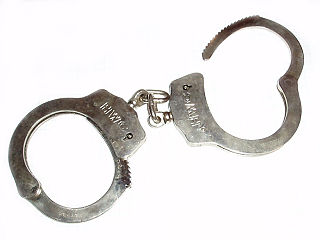Life imprisonment is any sentence of imprisonment for a crime under which convicted criminals are to remain in prison for the rest of their natural lives. Crimes that warrant life imprisonment are usually violent and/or dangerous. Examples of crimes that result in life sentences are murder, torture, terrorism, child abuse resulting in death, rape, espionage, treason, drug trafficking, drug possession, human trafficking, severe fraud and financial crimes, aggravated criminal damage, arson, hate crime, kidnapping, burglary, and robbery, piracy, aircraft hijacking, and genocide.

Measure 11, also known as "One Strike You're Out", was a citizens' initiative passed in 1994 in the U.S. State of Oregon. This statutory enactment established mandatory minimum sentencing for several crimes. The measure was approved in the November 8, 1994 general election with 788,695 votes in favor, and 412,816 votes against.

Juvenile delinquency, also known as juvenile offending, is the act of participating in unlawful behavior as a minor or individual younger than the statutory age of majority. The term delinquent usually refers to juvenile delinquency, and is also generalised to refer to a young person who behaves an unacceptable way.

The Youth Criminal Justice Act is a Canadian statute, which came into effect on April 1, 2003. It covers the prosecution of youths for criminal offences. The Act replaced the Young Offenders Act, which itself was a replacement for the Juvenile Delinquents Act.

The Juvenile Delinquents Act, SC 1908, c 40 was a law passed by the Parliament of Canada to improve its handling of juvenile crime. The act established procedures for the handling of juvenile offenses, including the government assuming control of juvenile offenders. It was revised in 1929 and superseded in 1984 by the Young Offenders Act.

A juvenile court, also known as young offender's court or children's court, is a tribunal having special authority to pass judgements for crimes that are committed by children who have not attained the age of majority. In most modern legal systems, children who commit a crime are treated differently from legal adults that have committed the same offense.
Winlaton Youth Training Centre was a Government owned and run female youth correctional facility located on 18 acres (73,000 m2) at 186 Springvale Road Nunawading, Victoria, Australia. The facility was designed to accommodate 14- to 18-year-old wards of the state. It opened in 1956 as the Winlaton Juvenile School, and closed in 1993 as the Nunawading Youth Residential Facility. A housing estate now occupies the site.

California Proposition 21, known also as Prop 21, was a proposition proposed and passed in 2000 that increased a variety of criminal penalties for crimes committed by youth and incorporated many youth offenders into the adult criminal justice system. Major provisions of the proposition, as summarized by Attorney General of California are:

The American juvenile justice system is the primary system used to handle minors who are convicted of criminal offenses. The system is composed of a federal and many separate state, territorial, and local jurisdictions, with states and the federal government sharing sovereign police power under the common authority of the United States Constitution. The juvenile justice system intervenes in delinquent behavior through police, court, and correctional involvement, with the goal of rehabilitation. Youth and their guardians can face a variety of consequences including probation, community service, youth court, youth incarceration and alternative schooling. The juvenile justice system, similar to the adult system, operates from a belief that intervening early in delinquent behavior will deter adolescents from engaging in criminal behavior as adults.
A diversion program, also known as a pretrial diversion program or pretrial intervention program, in the criminal justice system is a form of pretrial sentencing that helps remedy behavior leading to the arrest. Administered by the judicial or law enforcement systems, they often allow the offender to avoid conviction and include a rehabilitation program to prevent future criminal acts. Availability and the operation of such systems differ in different countries.
Juvenile law pertains to those who are deemed to be below the age of majority, which varies by country and culture. Usually, minors are treated differently under the law. However, even minors may be prosecuted as adults.
The youth justice system in England and Wales comprises the organs and processes that are used to prosecute, convict and punish persons under 18 years of age who commit criminal offences. The principal aim of the youth justice system is to prevent offending by children and young persons.
Juvenile delinquency in the United States refers to crimes committed by children or young people, particularly those under the age of eighteen.

R v DB, 2008 SCC 25 is a landmark decision of the Supreme Court of Canada on youth justice and sentencing. The Court held the provisions of the Youth Criminal Justice Act that required presumptive adult sentences for youth convicted of certain offences to be unconstitutional. Ruling that the presumption of diminished moral blameworthiness for young persons was a principle of fundamental justice under section 7 of the Charter of Rights and Freedoms and that the impugned provisions unconstitutionally deprived them of their liberty by presuming their moral blameworthiness to be equivalent to adults.
Life imprisonment in Canada is a criminal sentence for certain offences that lasts for the offender’s life. Parole is possible, but even if paroled, the offender remains under the supervision of Corrections Canada for their lifetime, and can be returned to prison for parole violations.

The United States incarcerates more of its youth than any other country in the world through the juvenile courts and the adult criminal justice system, which reflects the larger trends in incarceration practices in the United States. In 2010, approximately 70,800 juveniles were incarcerated in youth detention facilities alone. As of 2006, approximately 500,000 youth were brought to detention centers in a given year. This data does not reflect juveniles tried as adults. As of 2013, around 40% were incarcerated in privatized, for-profit facilities.

Trial as an adult is a situation in which a juvenile offender is tried as if they were an adult, whereby they may receive a longer or more serious sentence than would otherwise be possible if they were charged as a juvenile.

Sentencing in England and Wales refers to a bench of magistrates or district judge in a magistrate's court or a judge in the Crown Court passing sentence on a person found guilty of a criminal offence. In deciding the sentence, the court will take into account a number of factors: the type of offence and how serious it is, the timing of any plea of guilty, the defendant's character and antecedents, including their criminal record and the defendant's personal circumstances such as their financial circumstances in the case of a fine being imposed.
Raising the age of juvenile jurisdiction in the state of North Carolina has been an ongoing issue in the North Carolina General Assembly. There are currently two pieces of legislation focusing on this issue, Senate Bill 506 and House Bill 632, which seek to raise the age of jurisdiction from 16 to 18. Four members of the North Carolina House of Representatives serve as the primary sponsors and there are twenty-six co-sponsors. Most of U.S. States define an adult at 18 years old; however, North Carolina and New York define a juvenile who has committed a criminal offense as no older than 16, which places 16- and 17-year-olds in a position where they are tried as adults for any offense.
The youth justice system in New Zealand consists of organisations and processes that deal with offending by children aged 10–13 years and young people aged 14–16 years. These differ from general criminal processes, and are governed by different principles.









